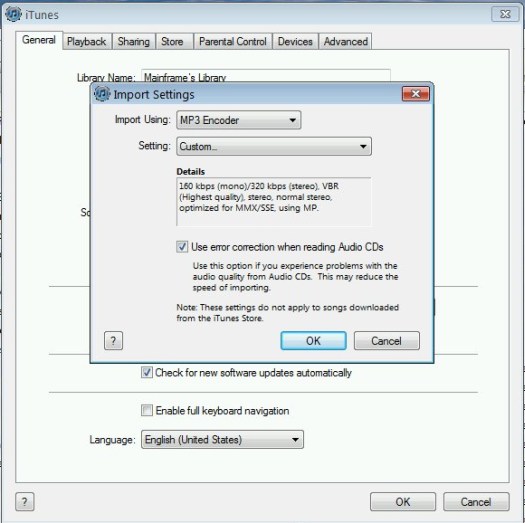

- #Itunes mp3 encoder settings install
- #Itunes mp3 encoder settings full
- #Itunes mp3 encoder settings portable
- #Itunes mp3 encoder settings download
Set custom settings for greater control over the quality and size of imported files when importing using AAC Encoder encoding format.Ĭhoose AAC Encoder from the Import Using pop-up menu.Ĭhoose Custom from the Setting pop-up menu. If needed, select the “Use error correction when reading Audio CDs” option. Higher Quality: Choose if you plan to create your own audio CDs or listen to your music with high-quality stereo speakers.Ĭustom: Choose for greater control over the file size and sound quality. This setting creates files that are about 1 MB in size per minute of music. High Quality: Choose if you play music in a noisy environment.
#Itunes mp3 encoder settings portable
Good Quality: Choose to fit more songs on a portable MP3 player with limited storage capacity. If you chose MP3 Encoder, you can choose one of the following: In most cases, the default selection works well. (Songs imported using this format take up much more disk space.)Ĭhoose a bit rate from the Setting pop-up menu (not available with Apple Lossless Encoder). WAV Encoder: Use if you’ll be playing your songs on a computer that doesn’t have MP3 software. MP3 Encoder: Use if you plan to listen to music in apps other than iTunes, or on MP3 players other than iPhone, iPad, or iPod. (Songs imported using this format take up much more disk space.)

(Songs imported using this format take up much more disk space.)Īpple Lossless Encoder: Use if you want to listen to imported songs on audiophile-quality sound systems without losing audio quality. You can listen to songs encoded using this format in iTunes, on iPhone and iPad, and on iPod models that come with a dock connector.ĪIFF Encoder: Use if you want to burn high-quality CDs with the songs you’re importing without losing audio quality. In the iTunes app on your PC, choose Edit > Preferences, click General, then click Import Settings.Ĭhoose an encoding format from the Import Using pop-up menu.ĪAC Encoder: Use for most music. Your choices affect the audio quality and size of the song file (the higher the quality, the larger the file size). Move your iTunes library to another computer.Add and edit information about items in your library.Turn on your device’s accessibility features.Back up your iPhone, iPad, or iPod touch.Create, delete, and use Smart Playlists.Create, edit, and delete standard playlists.Transfer purchases from a mobile device.Import from other computers using Home Sharing.Import items from your computer or another computer.See |Exporting using an External Program] for more help.
#Itunes mp3 encoder settings full
On Mac, you must give the full path to ffmpeg enclosed in quotes, instead of just "ffmpeg".įinally in the Export Audio dialog, add the M4A extension after the file name and dot. button, then enter the following command: Then export using the (external program) choice.
#Itunes mp3 encoder settings download
On Mac, search for and download a standalone "ffmpeg" binary online.
#Itunes mp3 encoder settings install
Instead, on Windows and Linux, install the optional FFmpeg library. You cannot export directly to Apple Lossless from the Export Audio dialog. Typically an Apple Lossless file is around half the size of an equivalent WAV file and more than three times the size of an equivalent AAC 256 kbps file. Like AAC it also uses files with the M4A extension.Īpple Lossless Encoder is quite similar to FLAC, producing larger files than AAC or MP3 but smaller than WAV. Apple Lossless is, as the name suggests, Apple's size-compressed lossless codec. For speech 128 kbps or even 64 kbps can be used as the bitrate if preferred.Īpple Lossless (Apple proprietary, lossless, smaller than WAV/AIFF)Īpple Lossless Encoding (sometimes referred to as ALAC - Apple Lossless Audio Codec) is also an Apple proprietary format. If you choose lossy formats (MP3 or AAC) the minimum bitrate setting you should use for music is 160 kbps, though 256 kbps is probably to be preferred - and in use on an iPod is unlikely to be distinguishable from WAV or AIFF (or Apple Lossless). The two main benefits are that you can fit many more songs into the device (for 256 kbps files you can fit about 10 times as many songs) and compressed files improve battery life, because disk reads are relatively heavy on battery power.

There are several advantages to using a compressed format on iPods and iPhones. If you have plenty of storage space on your device or a relatively small music library you may wish to consider the larger lossless WAV or AIFF formats. MP3 should be considered if you think that in the future you may wish to switch to an alternative portable music player or phone. AAC is the default format set in Apple Music/iTunes and the format Apple uses for audio files sold from the Apple Music/iTunes Store, so is the most obvious choice if you solely use Apple products.


 0 kommentar(er)
0 kommentar(er)
